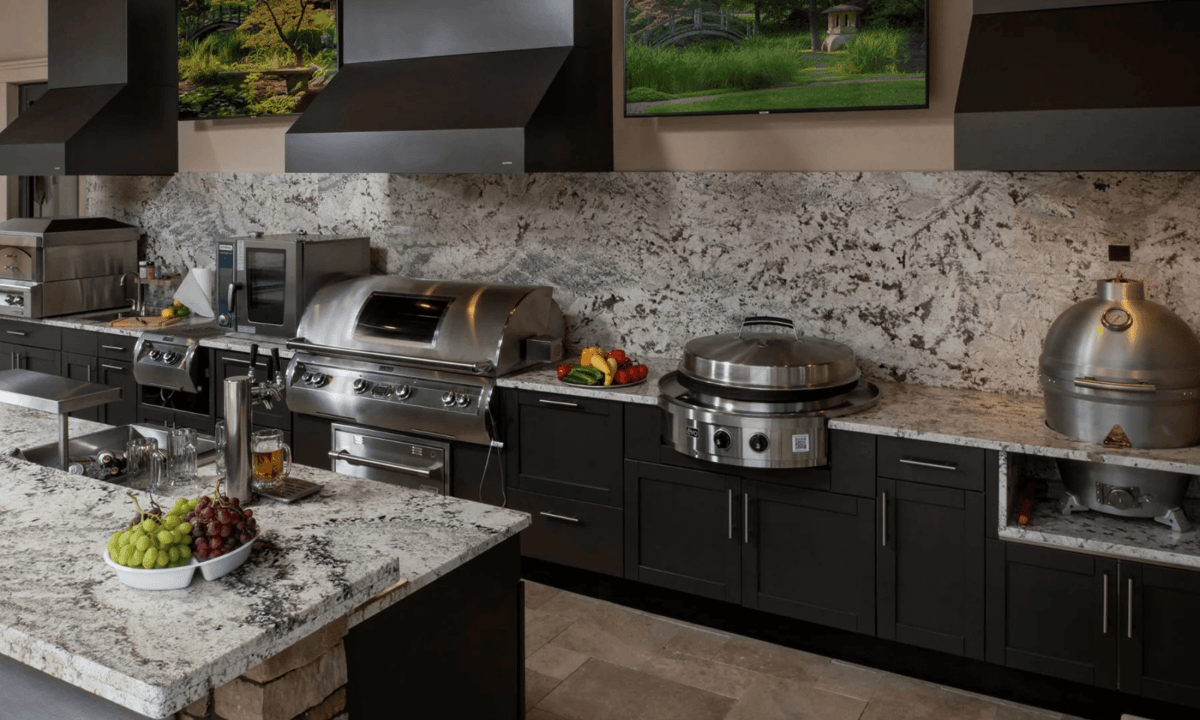Your Cart is Empty

Do I need an Outdoor Kitchen Vent? We are asked this question quite often at Riviera Outdoor Décor and the answer always the same. It depends on your local municipality, local building codes and ordinances. Each municipality features a different set of ventilation rules, and they must always be followed to the letter.
At Riviera Outdoor Décor, we recommend a vent hood for any grill that’s underneath a roof with at least 2 adjacent walls or anywhere poor cross-ventilation is occurring. The problems tend to come in when you get walls or a ceiling involved.
Preferably, yes since clearance is needed for the hinge on your grill from a wall, your vent hood should extend at least 3-4” in the front. Your vent hood should also extend at least 6 inches wider than your grill head (with a 3-inch overhang on either side). This ensures that most of the smoke and grease will be captured in the vent. If it’s more convenient, larger is perfectly fine and will leave you and your guest more comfortable while grilling and free from smoke.
 An excellent example of an Outdoor Kitchen Vent that is perfectly sized for the Outdoor Grill
An excellent example of an Outdoor Kitchen Vent that is perfectly sized for the Outdoor GrillThe standard is 36” inches above the countertop- Note: not grill but counter top. As always, we encourage verification with the owner’s manual.
A conservative estimate suggests your grill needs 1 CFM for every 100 BTUs (with a minimum of 1,200 CFM for the baseline), but this will vary between manufacturers. Basing your vent hood CFM off of your grill’s maximum BTU count is the best way to guarantee your outdoor kitchen vent can handle your grill’s smoke production.
It is critical to know the CFM and SONES (below) when purchasing your Outdoor Kitchen Vent. You should be able to find both the CFM and SONES with the product listing of the Outdoor Kitchen Vent. Here is an example
Most side burners do not require an outdoor vent. A single side burner just can’t output the kind of smoke a gas grill can. A standard vent hood at least 6 inches wider than the grill (as previously mentioned) and with sufficient CFM, based on the grill’s BTU count (please see above) — will take care of the side burner as well.
Some vent hoods can be ducted out through the wall, but most will need to snake through the ceiling of your outdoor kitchen structure. This depends heavily on the manufacturer, with a select few offering wall ducting options.
The mechanics of appropriate ducting are very much a case-by-case basis, and should be reviewed in the owner’s manual. The instructions must be followed exactly. A “close enough” does not work here. If the ducting is the wrong size, the blower will either plummet in efficiency or it simply won’t be capable of moving the given CRM. Either end result presents real problems for you.
At this time, ductless vent hoods have their uses… but not outdoors, they don’t. These models tend to move nowhere near enough CFM to properly vent an outdoor kitchen or BBQ grill — and that goes for downdraft vent hoods, too.
Compared to non-adjustable models, a vent hood with an adjustable blower can save money and especially overhead noise. Tweaking the fan speed means tweaking the airflow, and that means less CFM. An adjustable blower lets you turn down your vent hood to match cooking temperatures with cooking quantity level. With non-adjustable blowers, that vent hood blower is either “on” or “off” regardless of the cooking level.
The majority of outdoor vent hoods typically feature lighting. However, that is not always the case so always double-check.
Some outdoor kitchen vents can be rather loud. Refer to the Sones level (below) to ensure you are not purchasing a vent that is extremely loud. Many models operate extremely quietly thanks to proprietary blower technology.
For more information read below about Sones
Sones are a measure of volume similar to decibels, but specific to exhaust fans (from small bathroom fans to large ventilation equipment). Any given vent hood’s sone rating will offer a ballpark for how loudly or quietly they’ll run. To contextualize this: quiet refrigerators settle around 1 sone, light rain would fall around 3-4 sones, and regular conversation with background noise tends to begin around 6-7 sones.
Sone Level | Decibels (Rounded) | Equivalent Volume (Within 5 Feet) |
0.5 | 24 | Faint rustling leaves |
1 | 28 | A whisper |
2 | 38 | A calm library |
3 | 43 | Babbling brook or light rain |
4 | 48 | Humming refrigerator |
5 | 51 | Music played softly |
6 | 54 | Busy cafe |
7 | 56 | Normal conversation volume |
8 | 58 | Standard clothes dryer |
While no gas grill is truly complete without a vent hood (unless you’re cooking in a completely open location with proper ventilation), electric grills and pellet grills are a little more situational. These depend on the manufacturer, grill size, and local municipality codes.
 In this beautiful Outdoor Kitchen Design, note that most Grills have a separate Outdoor Kitchen Vent Hood.
In this beautiful Outdoor Kitchen Design, note that most Grills have a separate Outdoor Kitchen Vent Hood. If it makes a lot of smoke and electric smokers do, then it most likely requires a vent hood. This is specific mostly to electric smokers. As always, check with your local municipality as well as the owner’s manual of your smoker.
